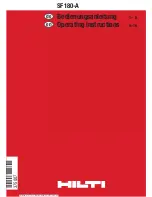
Note:
Before doing inspection and maintenance work, be
sure to turn off the switch and unplug the power plug.
Limit Wear Line
1.
The custodian must conduct a daily inspection
when the tool is sent out or taken back: the user
must conduct a daily inspection before use.
2.
The daily inspection of the tool should include at
least the following items:
a. Whether there is product certification mark and regular
inspection conformity mark.
b. Whether the shell and handle are cracked or damaged.
c. Whether the connection of the protective earthing
conductor (PE) is undamaged.
d. Whether the power cord is intact.
e. Whether the power plug is intact.
f. Whether the power switch is normal and flexible, and
whether it is defective or broken.
g. Whether the mechanical protection device is intact.
h. Whether the rotating part of the tool rotates flexibly,
briskly and without blocking.
i. Whether the electrical protection device is good.
3. The regular inspection should be conducted by a
full-time personnel in the tool using unit.
3.1 Check at least once a year.
3.2 In areas with damp heat and frequent temperature
changes or places with harsh operating conditions, the
inspection cycle should be shortened accordingly.
3.3 Inspection should be carried out in time before plum
rain season.
3.4 For regular inspection items of tools, the insulation
resistance of the tools must also be measured.
Insulation resistance should not be less than the value
specified in Table 1.
Insulation resistance should be measured with a 500v
megameter.
3.5 For tools that are regularly inspected and qualified, the
inspection "Qualified" mark should be pasted on the
appropriate part of the tool. The “Qualified” mark
should be bright, clear, correct and include at least:
a) Tool number
b) Name of inspection unit or mark
c) Name of inspector or mark
d) Effective date
4. For tools that have been left unused for a long time, the
insulation resistance must be measured before use. If
the insulation resistance is less than the value
specified in Table 1, it must be dried, and it can be
used after passing the inspection and pasting the
"Qualified" mark.
5. If the tool is damaged in insulation, the power cord
sheath is broken, the protective earthing conductor
(PE) falls off, the plug and socket are cracked, or the
mechanical damage is detrimental to safety, repair it
immediately. Do not continue to use until repaired.
6. Tool maintenance must be carried out by a maintenance
unit approved by the original manufacturer.
7. The use unit and maintenance department shall not
arbitrarily modify the original design parameters of the
tool, and shall not use substitute materials that are
lower than the performance of the raw materials and
components that do not conform to the original
specifications.
8. During maintenance, the insulating gaskets and
sleeves in the tool must not be arbitrarily removed or
missing, and the power cord of the tool must not be
arbitrarily exchanged.
Table 1
Table 2
Inspection and Repair
Maintenance and Service
Insulation resistance/MΩ
Measuring position
Between live parts and housing:
- Isolation from live parts only by
basic insulation
- Isolation from live parts by
reinforced insulation
Test voltage/V
Class I tools Class II tools Class III tools
2
7
1
Measuring
position
Between live
parts and
housing
9. After the electrical insulation part of the tool is repaired,
the dielectric strength test must be carried out
according to the requirements of Table 2.
The waveform is an actual sine wave, and the test
voltage with a frequency of 50 Hz is applied for 1 min
without insulation breakdown or flashover.
The test transformer should be designed as follows:
after the output voltage is adjusted to an appropriate
test voltage value, when the output terminal is
short-circuited, the output current is at least 200mA.
10. After the tools have been repaired, inspected and
tested qualified, they should be pasted with a
"Qualified" mark on the appropriate part: for tools that
cannot be repaired or cannot meet the due safety
technical requirements after repairs, they must go
through the scrap procedures and take isolation
measures.
In order to ensure the safety and reliability of the
product, please send your electric tools to profession-
al maintenance personnel for repair.
Please use our company's original accessories.
Cleaning air vent
The air inlet and outlet of the tool must be kept clean. It
should be cleaned regularly or cleaned at any time
when blockage occurs.
Checking drill bit
If the drill bit is found to be worn, the drill bit should be
replaced immediately or the drill bit should be
sharpened again. Otherwise it will cause motor
overload and reduce drilling efficiency.
Checking mounting screws
Frequently check whether the mounting screws are
loose to avoid accidents.
Replacing carbon brush
Regularly check and replace the carbon brush. When it
wears to the limit wear line, it needs to be replaced.
Keep the carbon brush clean and make it slide freely in
the brush holder. The two carbon brushes should be
replaced at the same time.
Open the casing with a screwdriver, take out the worn
carbon brushes, insert new carbon brushes in the brush
holder, and then close the casing.
1250
3750
-
3750
500
-
Содержание PED 02-10
Страница 1: ...PED 02 10 ELECTRIC DRILL ...
























